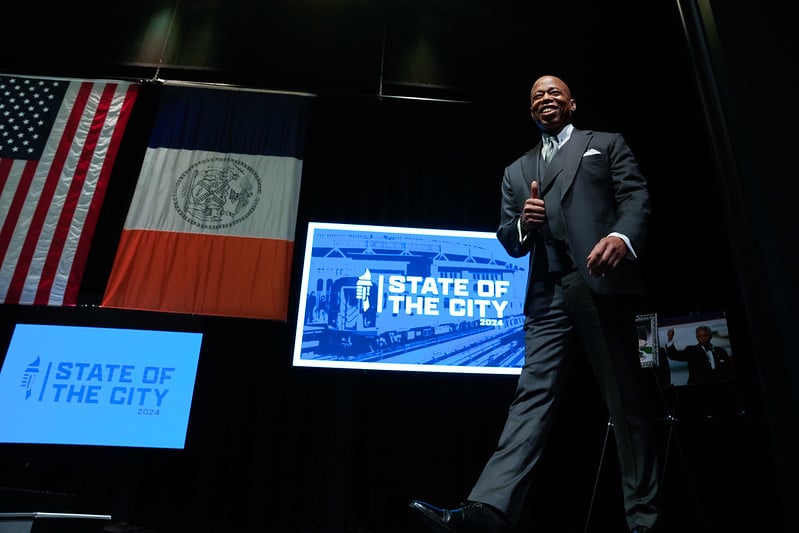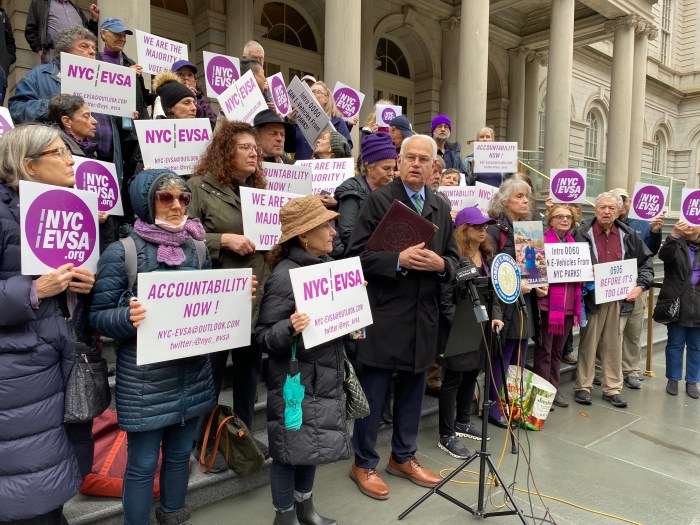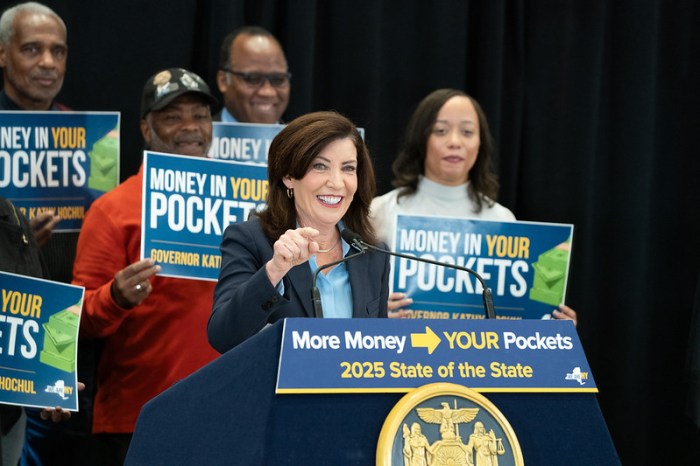Mayor Eric Adams on Wednesday delivered his third State of the City address, a speech that celebrated his purported victories at the halfway point of his first term and offered a few new policy proposals.
Adams’ speech, which he delivered at Hostos Community College in the South Bronx on Jan. 24, included some new initiatives for combating the city’s housing crisis, the negative impacts of social media on children’s mental health and expanding public space in areas like Manhattan’s Chinatown.
Perhaps looking ahead to a 2025 re-election campaign, Hizzoner kicked off his address by repeating the “crime is down, jobs are up” mantra he has been trumpeting in recent weeks. The phrase refers to drops in murders and shootings as well as gains in jobs lost during the pandemic since Adams took office in 2022.
“Two years in, we are seeing real results, crime is down, jobs are up and everyday we are delivering for working class New Yorkers,” the mayor said. “Thanks to the hard work of this administration and millions of dedicated New Yorkers, the state of our city is strong.”
The mayor gave the address at a time when his mayoralty has been bogged down by myriad crises, including an FBI probe into his 2021 campaign, the unrelenting migrant influx and deeply unpopular budget cuts. Nonetheless, his speech struck an overwhelmingly positive tone.
The address drew attendees like Public Advocate Jumaane Williams and Council Speaker Adrienne Adams, with whom the mayor has recently found himself at odds over legislation they passed to boost police transparency and ban solitary confinement in city jails — both of which he vetoed last week.
Notably absent from the affair were Gov. Kathy Hochul, state Sen. Majority Leader Andrea Stewart-Cousins and Assembly Speaker Carl Heastie.
Following the address, Williams said that while he liked certain parts of Adams’ speech, he was not pleased that the mayor did not mention the recent vetoes of the police reporting and solitary measures.
“I thought it was a decent speech, [it] had some good things in there,” Williams told reporters. “Obviously, ostensibly left [unsaid] was discussion of the bills, one of them just a reporting bill. The mayor still seems to be trying to rip the city apart on a reporting bill.”
Housing
The mayor dedicated a hefty portion of his roughly 40-minute address to combating the housing crisis gripping the five boroughs, both through a couple of new city-led proposals and calling on Albany to take action that would allow the city to build more.
The main proposal is to use 24 city-owned sites to build and preserve 12,000 units of affordable housing — a plan dubbed “24 In 24.” The city is looking at sites that are controlled by the city Economic Development Corporation, Department of Housing Preservation and Development and the New York City Housing Authority.
Maria Torres-Springer, the deputy mayor for Housing, Economic Development and Workforce, told amNewYork Metro said the Grand Concourse Library on 173rd Street in the Bronx will be one of the sites included in the project.
“They really do run the gamut from very big sites, to smaller sites, to NYCHA preservation deals that are going to move forward very aggressively,” Torres-Springer said. “We can’t leave any stone unturned. Everywhere there’s a public site, we have to not just identify whether they’re good for housing, but we have to advance those projects aggressively in order to make a dent in the housing crisis.”
Adams is also launching a “Tenant Protection Cabinet,” which would give access to the same information and resources for tenants regardless of which city agency they reach out to, according to a report from Politico New York. The cabinet will focus on helping tenants through illegal lockouts and landlords trying to boot them from their apartments.
The mayor also repeated his call for Albany lawmakers to advance measures like a new affordable housing tax incentive to replace 421-a and making it easier to do office to residential building conversions.
“Gov. Hochul was right in her State of the State address, New York City must build,” Adams said. “But we need the state to clear the way for the housing we need. Let us build.”
City Council Housing Committee Chair Pierina Sanchez told amNewYork Metro that while she is mostly pleased with the mayor’s efforts to build more housing, she would still like to see him enact a package of laws to expand housing vouchers — known as CityFHEPS — last year that his administration has refused to implement.
“I hope the administration will come around and implement the CityFHEPs reforms that we have passed in the City Council and he vetoed and we overrode,” she said.
Social Media
Adams also used his speech to address an issue he speaks about often: the harmful effects of social media on young people’s mental health. He called out specific social media companies including TikTok, YouTube, and Facebook.
“We cannot stand by and let big tech monetize our children’s privacy and jeopardize their mental health,” he said.
To tackle the issue, Adams directed his health commissioner, Dr. Ashwin Vasan, to issue an advisory designating young people’s “unfettered” access to social media as an official public health hazard in the city. Adams said New York is the first major city in the country to take such an action.
Vasan said the advisory guides parents and caregivers to delay children from accessing social media until age 14, when they should reassess. They are also producing tools and conversation guides to help parents and young people navigate social media use.
“What we’re doing is providing a playbook for people to start to have those conversations in a standardized way and also to create community,” Vasan said. “It’s reshaping the relationship between young people and social media, it’s not about getting rid of it. It’s harm reduction.”



































